In an era when automobiles were slated to change the world, Orillia was a player.
The Early Years
In 1854, William Tudhope got his start as a blacksmith near Jarratt in Oro Township where he made iron hardware, harness and wagon parts. By 1876, he had relocated to a site on Andrew Street in Orillia where he expanded into building horse-drawn carriages of all types. He called his business the Tudhope Carriage Company. William, in addition to being an excellent craftsman, was a visionary. With the advent of the railway across the country, he travelled throughout Canada, setting up a network of sales agents. This soon resulted in excellent sales and an ongoing expansion of the plant’s capacity. At its peak, and after taking over a couple of its competitors, the Tudhope Carriage Company was believed to be the largest producer of horse drawn vehicles in the country and maybe even the British Empire.

Additionally, William and his sons founded several other local companies, including the Orillia Tudhope Anderson Company (later known as OTACO), Standard Chemical, Tools and Hardware, and Canada Wood Specialities, a large woodworking factory.
The Age of the Automobile
With the arrival of the twentieth century, automobile production became somewhat of a craze in manufacturing across North America, with countless designers and entrepreneurs wanting to get in on the ground floor. In Orillia, the Tudhope Carriage Company, now under the leadership of William’s son James, had been producing high quality horse-drawn vehicles for more than a generation and marketing its products through an extensive sales network. Like many other industrialists, J.B., as he was known, investigated the possibility of using American design in a car built for the Canadian market. In those years, there were high tariffs on automobiles imported from the USA, so it paid to produce cars on Canadian soil. In Oshawa, J.B.’s good friend and competitor in the carriage trade, Sam McLaughlin, was manufacturing Buicks for the Canadian market, and the Ford Motor Company of Canada was thriving in Walkerville, near Windsor.
In September 1908, the Orillia Packet and Times reported that a Tudhope automobile was being tested and demonstrated. Combining mechanical components purchased from the W. H. McIntyre Company of Auburn, Indiana, with Tudhope bodies, fenders, wheels and trim, the first Orillia-built cars, known as Tudhope McIntyres, were soon available for sale to the automobile-hungry public. With high, buggy-type wheels and simple body design, they closely resembled horse-drawn carriages, but their two-cylinder, air-cooled engines, double chain drive and wheel steering meant owners could drive their vehicles down the road without the help of the traditional horse.
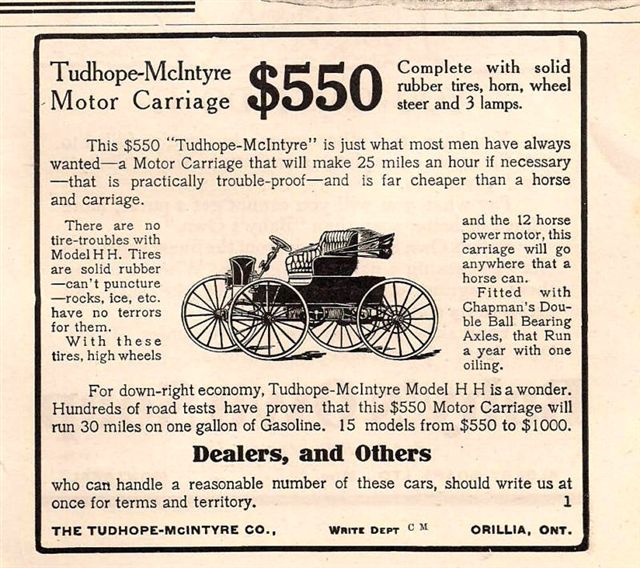
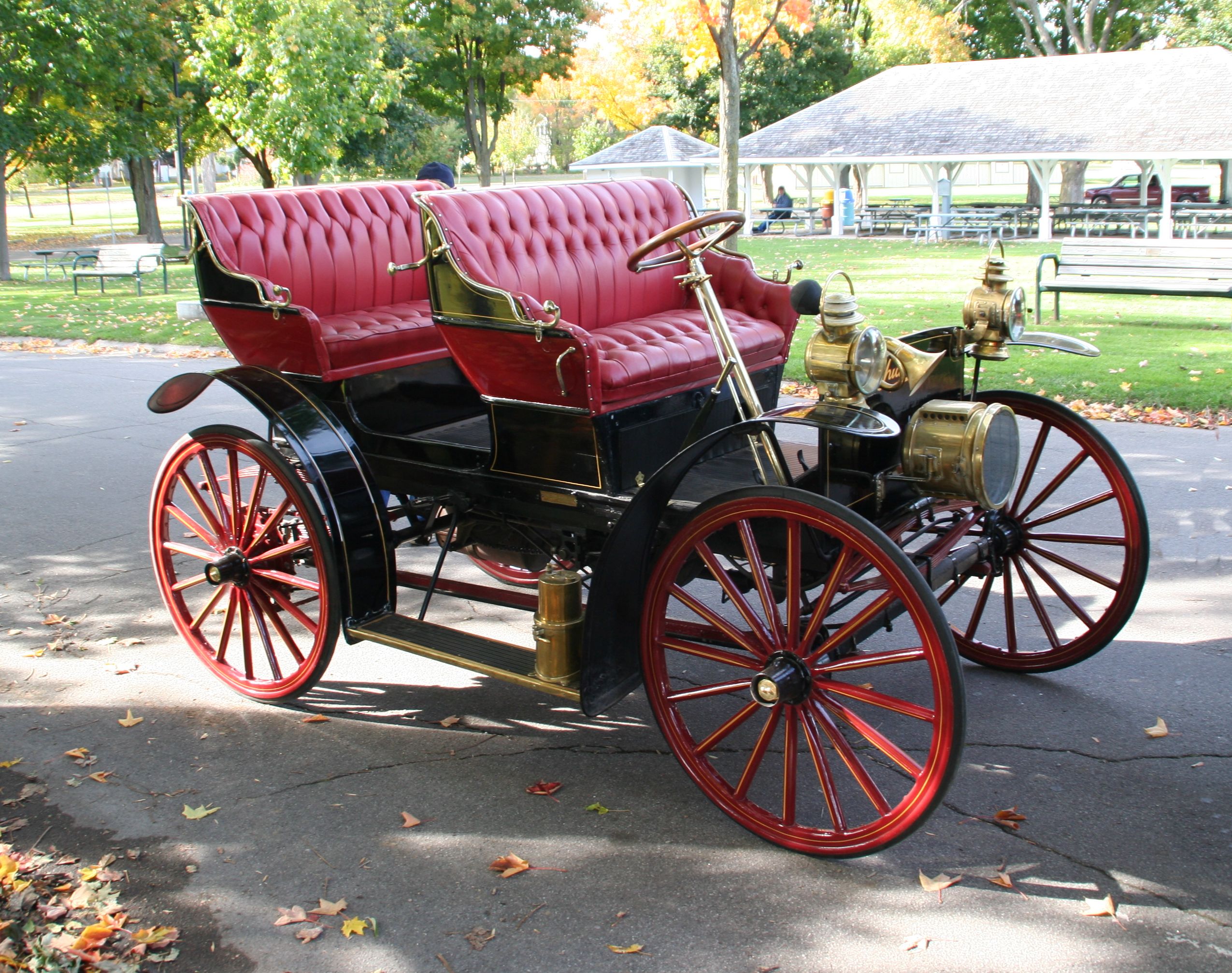
Production figures are lost, but in a few months, Tudhope’s produced a substantial number of these primitive automobiles, and they were marketed all across the country through the company’s carriage sales agents. They had some prestigious early customers, including the Bell Telephone Company. In August of 1909, however, disaster struck when the factory burned to the ground, just as cars were being readied for the CNE automotive show.
Undaunted, J.B. immediately began planning the construction of a new factory to produce carriages and automobiles. Within weeks, the work began, and J.B. investigated arrangements with other American automobile companies. He knew that the McIntyre design was outdated and would quickly lose public appeal. Soon he contracted with the Metzger Motor Car Company of Detroit Michigan to build a Canadian version of its Everitt 30. William Metzger and Byron Everitt (a Canadian who went to Detroit to make his fortune) were the principals of the Metzger company and at the time were as well-known and respected as Henry Ford and the Dodge brothers.
J.B. was not a man to do anything by halves, and this time he intended to build automobiles in their entirety, rather than relying on American parts. To this end, he established the Tudhope Motor Company as a separate entity, purchased state-of-the-art machinery and looked to build a team of men with experience in the automotive industry. Using the Everitt design, Tudhope’s cast engine blocks, cut gears, stamped out frame components, built bodies, and assembled everything into high-quality machines.
The new models, which began to come off the line for the 1911 model year, were known as Everitt 30’s, but sales materials pointed out the many special Tudhope features that added to their value. With four-cylinder, water-cooled engines, magneto ignition, and three-speed transmissions, they included some of the best ideas in automotive engineering in an era when the automobile was in a constant state of evolution. By early 1912, a sleek and powerful six-cylinder 6-48 was added to the line, and in all models body and fender design showed the beginnings of streamlining.
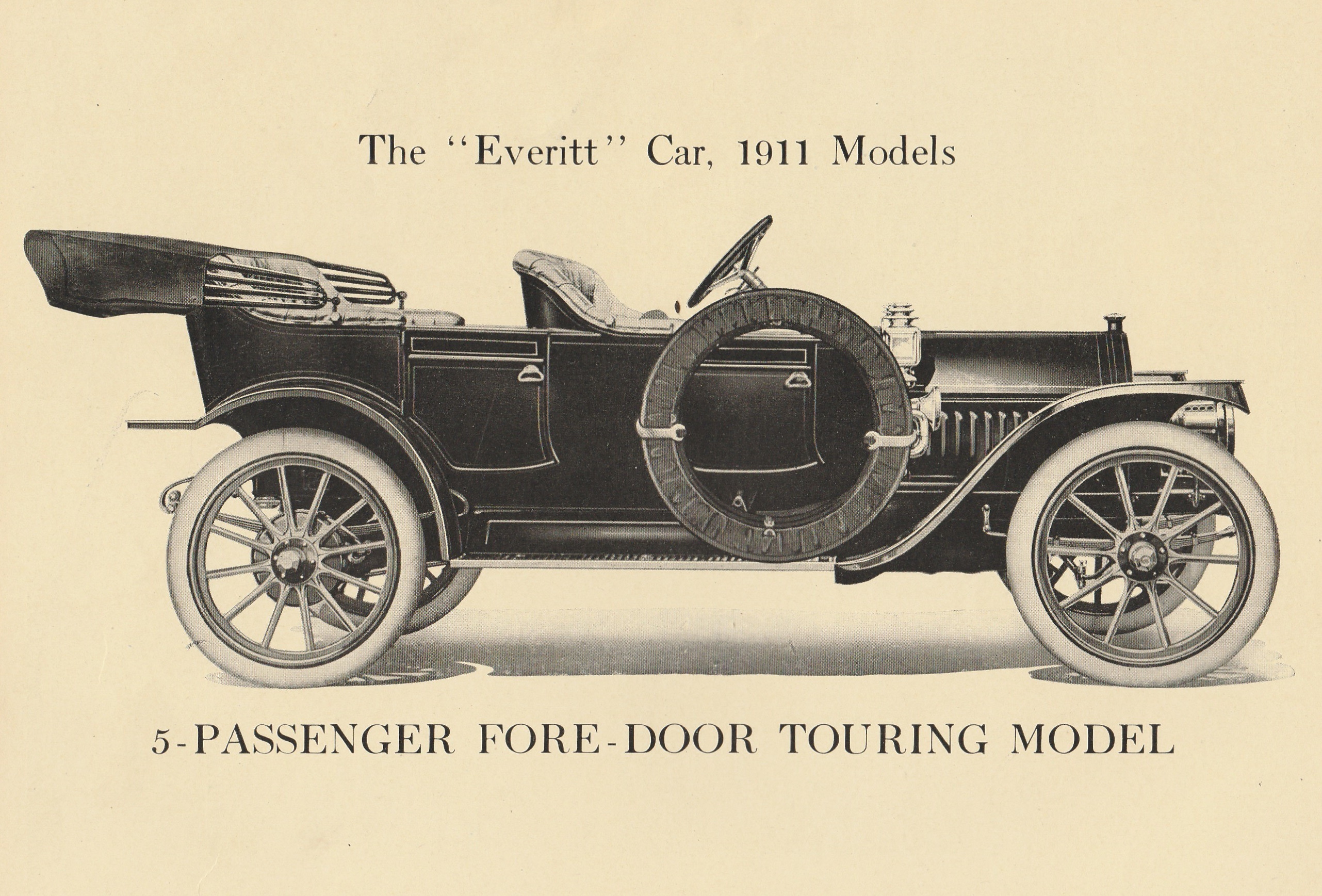
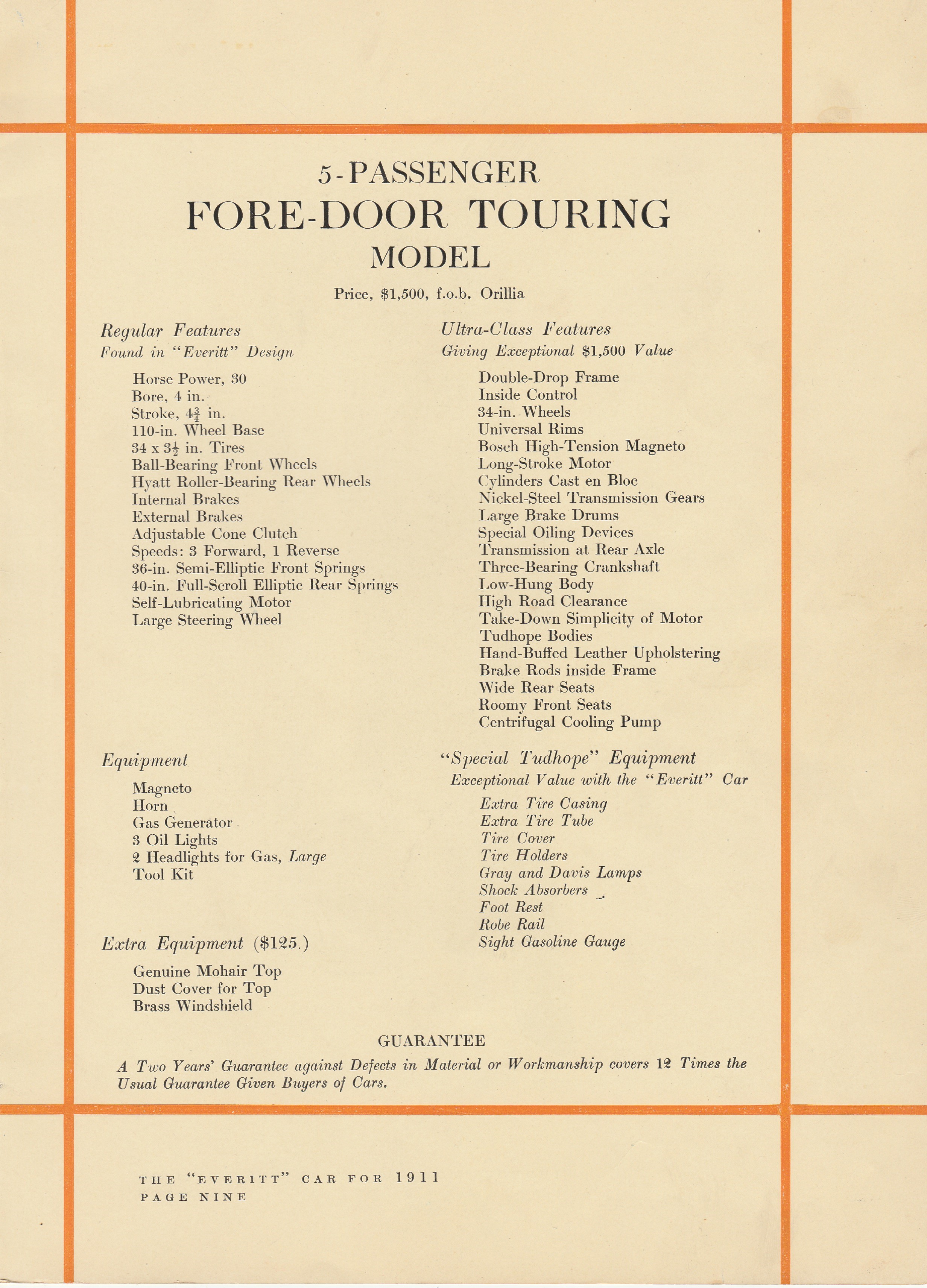
The future looked rosy, but in mid-1912 and without notice, the American parent company went through a complete reorganization, and was soon swallowed up by United States Motor Company, a large automotive conglomerate designed to compete with the recently formed General Motors and the skyrocketing Ford Motor Company. The business arrangement with Tudhope’s was terminated, and American production of the Everitt 30 ceased. It also meant the end of research and development for the Tudhope Motor Company, because it depended on the Metzger company for those services. Left on its own, the Orillia operation carried on, with the cars known simply as Tudhopes.
By 1913, the cars were equipped with electric lighting, eliminating the need to fiddle with acetylene and kerosene lamps. The six cylinder cars also had electric start. However, sales were slipping, because of quickly aging engineering and competition from lower-priced vehicles such as the Model T Ford. Furthermore, it wasn’t easy to find workers with automotive or machining experience; there were challenges in producing sufficient numbers of cars with a largely unqualified staff. Later that year, the Tudhope Motor Company was taken over by Frank Fisher and a group of investors. The brand was changed to Fisher, and the sales offices were moved to Walkerville, Ontario, but the cars were still built in the Orillia plant.
Unfortunately, sales continued to be weak, and by early 1914 the end was near. The advent of World War One marked the end of automobile production in Orillia, with remaining parts being used for ambulances bound for European battlegrounds. Meanwhile, Tudhope’s maintained production of horse-drawn vehicles, although with declining sales as more and more people made the switch to automobiles.
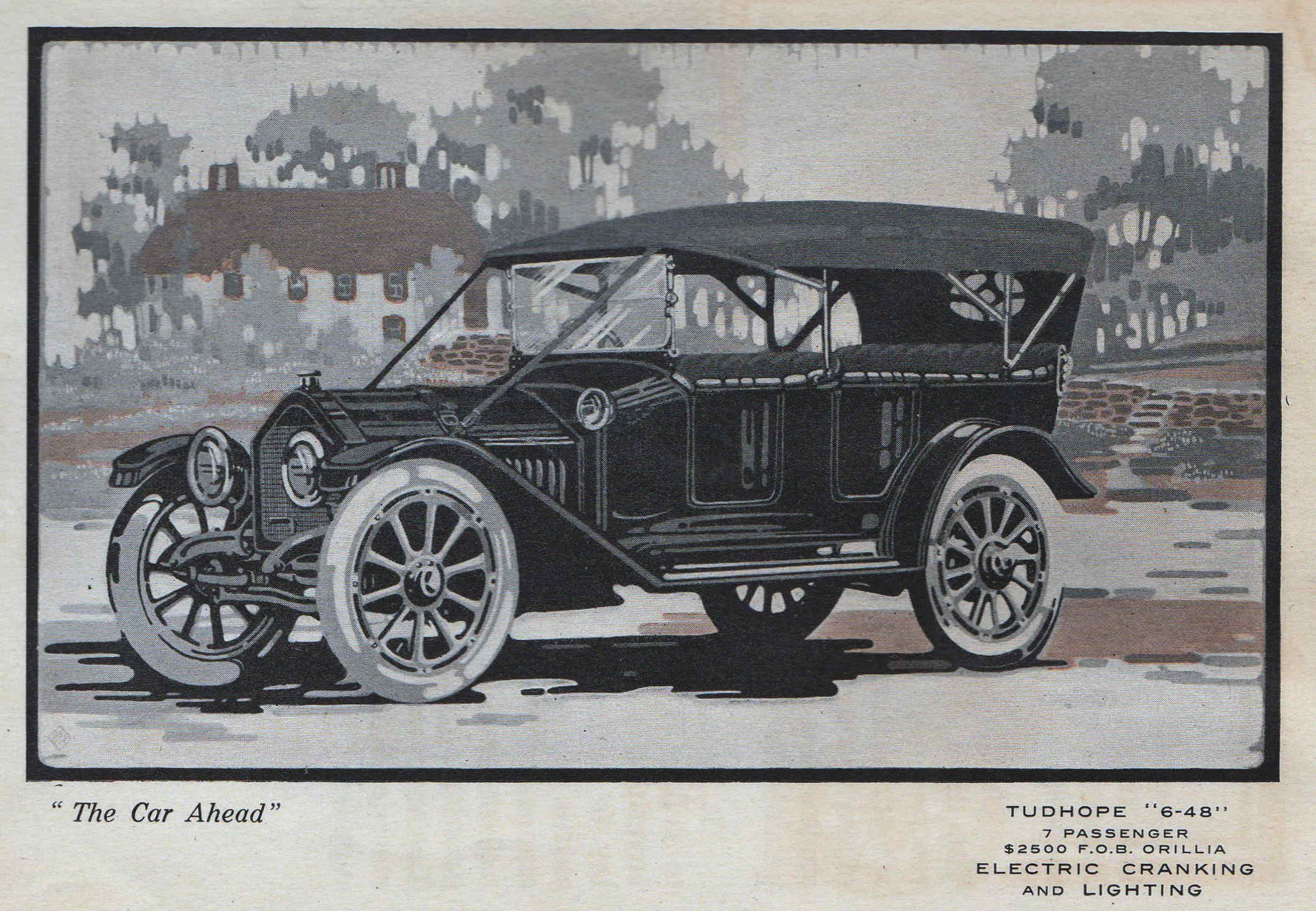
New Directions
After the war, through a branch called Orillia Bodies, Tudhope continued with an involvement in the automotive industry through manufacturing bodies for a variety of marques, including Overland, Essex, Yellow Cab, and Brooks. There was even the occasional custom body designed and built, including one for a Rolls-Royce Silver Ghost.
Fisher Motors, in their part of the plant, made a broad range of automotive accessories and also developed an innovative ice cream scoop which proved to be an excellent seller. It was available in various sizes, for both domestic and commercial use.
By the late twenties, Fisher Motors and Orillia Bodies had wound up their operations, and thus brought an end to Orillia’s participation in the Canadian automotive industry. Imagine what might have happened if J.B. Tudhope had “tied his horse” to, say, the Dodge Brothers. Orillia might still be home to a vibrant automotive industry. In Oshawa, what Sam McLaughlin started has survived as General Motors of Canada, and the Ford Motor Company of Canada is thriving too, albeit no longer in Walkerville.
Perhaps the best thing about this story is that we are fortunate to have two restored, operational examples of locally built automobiles for people to see and admire on an ongoing basis. The next time you see a Tudhope car, think about how it tells a story from Orillia’s past, and dream for a moment about what might have happened if things had evolved just a little bit differently.
For more than a decade after Tudhope Motor Co. had disappeared, Tuhdope's carriage company carried on until it was sold in 1924. TACO became OTACO in 1928.
Additional Information:
- An excellent synopsis of the early history of the Tudhope family in Orillia and region (spanning close to 200 years) is published by the Simcoe County Historical Association
- The breadth of contributions made by J.B. Tudhope to the development of Orillia can be appreciated by reviewing his induction into the Orillia Hall Of Fame and by reviewing his biography on Wikipedia
- After the end of WW1, Fisher Motor Company continued to operate for many years in Orillia. More information is published on our website under Postcard Memories: "Fisher Scoop", "Ice Cream Scoops", "The Piat Shell"
- Postcard Memories section of our website contains additional pictures related to Tudhope Automobiles: "1913 Tudhope 6-48 Postcard", "The Tudhope Carriage Plant"
- Our YouTube channel contains a video on the History of OTACO
- The Photos section of our website contains some pictures of our 1912 Tudhope Car on Parade.
